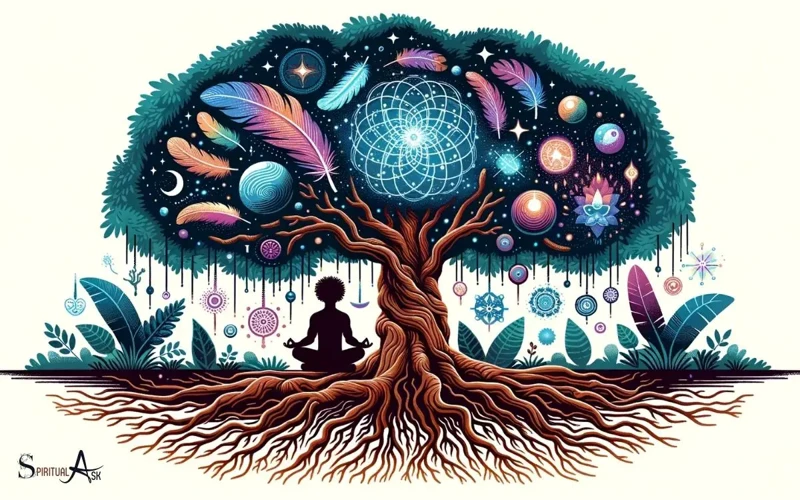Dreams hold a mysterious allure, captivating our imagination as we try to decipher their hidden meanings. Among the swirling tapestry of dreams, nightmares can be particularly perplexing. Why do we dream about scary things? What secrets do these unsettling visions hold? In this thought-provoking article, we delve into the intriguing interpretation of dream nightmares. We will explore the significance of dreams, unpack the meaning of nightmares, delve into psychological interpretations, contemplate spiritual and metaphysical explanations, and provide practical ways to interpret and embrace these unsettling dreams. Join us on this captivating journey as we unravel the enigma of why we dream about scary things.
The Significance of Dreams

Dreams have long been a subject of fascination and curiosity. They offer a window into our subconscious mind, revealing hidden desires, fears, and emotions that we may not be aware of during our waking hours. The significance of dreams extends beyond mere entertainment or random mental activity during sleep. They serve as a reflection of our innermost thoughts and experiences, providing valuable insights into our psychological and emotional well-being. Dreams can be seen as a complex tapestry, woven with multiple layers of meaning. They can serve as a reflection of inner fears, acting as a canvas where our anxieties come to life. Additionally, dreams can convey symbolic messages, using imagery and metaphor to communicate deeper truths. Dreams function as processing mechanisms, helping us make sense of the events and emotions we encounter in our daily lives. Whether they leave us perplexed, frightened, or intrigued, dreams hold a profound significance that goes beyond their ephemeral nature.
1. Dreams as Reflection of Inner Fears
Dreams have the ability to reflect our inner fears in a way that is both intriguing and unsettling. When we experience nightmares, it is often an indication that our deepest anxieties and apprehensions are bubbling to the surface. These dreams can take on various forms, portraying scenarios that tap into our most primal fears. It is through these unsettling visions that we may gain insights into the fears that we may not be fully aware of in our waking life. Nightmares can serve as a mirror, reflecting our hidden insecurities and vulnerabilities back to us. As we confront and explore these fears within the realm of our dreams, we are provided with an opportunity to better understand and address them in our waking life.
2. Dreams as Symbolic Messages
Dreams have a fascinating ability to convey messages through symbolism. When we dream, our subconscious mind often communicates using metaphors, allegories, and symbols. These symbolic messages can serve as a guide to our waking lives, offering insights and deeper understanding. For example, dreaming about being chased might symbolize a sense of avoidance or running away from a problem or fear. Dreaming of falling can represent a feeling of instability or losing control in some aspect of life. Interpreting these symbolic messages requires careful reflection and introspection, as the personal meaning behind each symbol may vary from person to person. By unraveling the symbolism in our dreams, we can gain a greater understanding of our emotions, desires, and challenges, helping us navigate the complexities of our waking world.
3. Dreams as Processing Mechanisms
Dreams serve as processing mechanisms, allowing our minds to make sense of the experiences, emotions, and information we encounter while awake. During sleep, our brain consolidates memories, sorts through thoughts and feelings, and establishes connections between various pieces of information. It is believed that dreams play a crucial role in this processing and integration of information, helping us organize and understand our experiences on a deeper level. By exploring themes, symbols, and scenarios in our dreams, we gain insight into our own thoughts and emotions. Dreams as processing mechanisms provide a unique opportunity for our subconscious mind to work through unresolved issues, reconcile conflicting emotions, and find resolution. They offer a therapeutic function, allowing us to process and heal from our waking experiences, ultimately aiding in personal growth and understanding.
Unpacking the Meaning of Nightmares

Nightmares, with their menacing and distressing nature, can leave us feeling shaken and unsettled upon waking. Unraveling the meaning behind these haunting dreams is a fascinating endeavor. One possible explanation for nightmares is unresolved anxiety and stress. These dreams can serve as a reflection of our subconscious fears and worries, allowing our mind to process and release these pent-up emotions during sleep. Another interpretation is that nightmares may stem from traumatic experiences and post-traumatic stress. The mind may use dreams as a way to revisit and confront these past traumas, albeit in a symbolic and often distressing manner. Additionally, nightmares can be a manifestation of our fear of the unknown and our inherent feelings of insecurity. They can reflect our subconscious apprehensions and serve as cautionary tales, urging us to address our fears and insecurities in order to find inner peace. Unpacking the meaning of nightmares opens a doorway into the depths of our psyche, offering insights and opportunities for growth and healing.
1. Unresolved Anxiety and Stress
Unresolved anxiety and stress can manifest in our dreams as frightening and unsettling scenarios. When we are unable to process or resolve our anxious thoughts and emotions while awake, they may find their way into our dream world. These dreams can serve as a release valve for pent-up stress, allowing us to confront and process our fears in a symbolic and metaphorical way. Nightmares related to unresolved anxiety and stress may feature scenarios such as being chased, falling, or being trapped, reflecting our feelings of being overwhelmed or unable to escape from our anxieties. Exploring these dreams can offer valuable insights into our emotional well-being and help us identify areas in our waking lives that require attention and resolution to find peace and alleviate the impact of unresolved anxiety and stress.
2. Traumatic Experiences and Post-Traumatic Stress
Traumatic experiences and post-traumatic stress can deeply impact our dreams, leading to the manifestation of scary and unsettling nightmares. When someone has gone through a distressing event or trauma, their subconscious mind may attempt to process and cope with the overwhelming emotions and memories during sleep. These nightmares can serve as a way for the mind to express and release the trauma and associated fears. The content of these dreams may closely mirror the specific events or themes related to the traumatic experience, contributing to intense feelings of fear, anxiety, and helplessness. In some cases, the nightmares may persist as a symptom of post-traumatic stress disorder (PTSD), prolonging the individual’s distress and affecting their overall well-being. Understanding the connection between traumatic experiences and nightmares can be vital for individuals seeking to heal and overcome the lingering effects of their past trauma.
3. Fear of the Unknown and Insecurity
Dreams can often tap into our deep-seated fear of the unknown and feelings of insecurity. It is not uncommon for scary or unsettling dreams to arise from our anxieties about uncertain situations or the unfamiliar. These dreams may mirror our apprehensions about the future, change, or stepping outside of our comfort zones. They can also reflect our insecurities and self-doubt, amplifying our worries and vulnerabilities as we navigate through life. Dreaming about scary things in the context of the fear of the unknown and insecurity allows us to confront these emotions in a safe and controlled environment, offering an opportunity for self-reflection and growth. By exploring these dreams and uncovering their underlying messages, we can gain a better understanding of our fears and work towards overcoming them in our waking lives.
Exploring Psychological Interpretations

When exploring the psychological interpretations of dreams, we encounter a myriad of perspectives that shed light on the complex workings of the human mind. From the psychoanalytic perspective put forth by Freud, dreams are seen as representations of repressed desires, fears, and unresolved conflicts. According to Jungian theories, dreams tap into the collective unconscious, archetypes, and universal symbols that connect us all. Cognitive psychologists propose the Threat Simulation Theory, suggesting that dreaming about scary things serves as a means for our brain to simulate and prepare for potential threats. Another psychological lens to consider is the role of emotional regulation and fear conditioning, where nightmares may be a reflection of our subconscious efforts to process and overcome fear. As we delve deeper into these psychological interpretations, a captivating and multifaceted understanding of dream nightmares emerges, reminding us of the complexity and depths of our inner worlds.
1. Psychoanalytic Perspective: Freudian Theories
Psychoanalytic perspective, rooted in Freudian theories, offers an intriguing lens to interpret dreams about scary things. Freud believed that dreams were a window into the unconscious mind and served as a mechanism for wish fulfillment. According to his theory, nightmares could be indicative of repressed desires or unresolved conflicts. Analyzing the symbolism and hidden meanings in these dreams can provide valuable insights into the deeper workings of the subconscious. By exploring the themes, imagery, and emotions present in these nightmares, one can unravel the underlying psychological factors that contribute to their occurrence. Within the realm of psychoanalytic perspective, understanding the influence of the unconscious on our dreams can shed light on the messages conveyed through terrifying and unsettling dreams.
2. Jungian Perspective: Collective Unconscious and Archetypes
Jungian Perspective emphasizes the idea of the collective unconscious and archetypes in understanding dream nightmares. According to Carl Jung, the collective unconscious represents the shared psychological inheritance of our ancestors that influences our thoughts and behaviors. Within this collective unconscious, exist archetypes – universal symbols and patterns that are deeply ingrained in the human psyche. When we dream about scary things, Jungian analysis suggests that we are tapping into these archetypal images, which carry profound meaning and represent our collective fears. By exploring these archetypes and their associations, we can gain a deeper understanding of the messages our nightmares convey and the underlying psychological dynamics at play.
3. Cognitive Perspective: Threat Simulation Theory
Cognitive Perspective: Threat Simulation Theory suggests that nightmares, including those with scary themes, serve a vital function in preparing us to deal with potential threats and dangers. According to this theory, during REM sleep, our brain simulates various threatening scenarios, enabling us to rehearse and develop strategies for survival. These dreams create an opportunity for us to process and confront our fears in a safe environment, helping us develop adaptive responses to potential dangers. The intense emotions experienced during nightmares allow our brain to practice emotional regulation and build resilience in the face of adversity. While waking life may not always be as frightening as our nightmares, this cognitive perspective highlights the value of these unsettling dreams in preparing and equipping us to navigate real-life challenges.
4. Emotional Regulation and Fear Conditioning
Emotional regulation and fear conditioning play a crucial role in understanding why we dream about scary things. Our dreams serve as a platform for our brain to process and regulate intense emotions, including fear. During the dreaming state, our brain experiences a form of emotional conditioning, where it reinforces certain emotions and responses associated with fear. This conditioning can occur as a result of past traumatic experiences or ongoing anxieties. The dreams involving scary things may serve as a way for our brain to confront and process these emotions, ultimately helping us to regulate and manage fear in our waking lives. By exploring these dreams and understanding the underlying emotional regulation and fear conditioning, we can gain insights into our own emotional well-being and work towards finding resolution and healing.
Spiritual and Metaphysical Explanations

In the realm of spiritual and metaphysical explanations, nightmares hold a deeper significance that transcends the boundaries of our conscious understanding. Some believe that these unsettling dreams could be a manifestation of spiritual warfare, where negative energies and entities disrupt the peace of our subconscious realm. Nightmares can also be a reflection of our inner shadow and the need for shadow work, a process of uncovering and integrating our repressed or hidden aspects. For those who believe in past lives, nightmares may be linked to karmic patterns and unresolved traumas from previous incarnations. Dreams can be seen as symbolic messages from the subconscious, offering guidance and insight into our spiritual journey. Whether one approaches nightmares from a spiritual or metaphysical perspective, they are seen as a gateway to deeper self-discovery and spiritual growth.
1. Spiritual Warfare and Dark Energies
One possible explanation for dreaming about scary things is the belief in spiritual warfare and the influence of dark energies. Some individuals interpret nightmares as battles between good and evil forces, where negative entities try to infiltrate their subconscious mind. According to this perspective, the dreamer may perceive these intense and frightening dreams as a reflection of ongoing spiritual battles or encounters with malevolent energies. The concept of spiritual warfare suggests that these dreams might be warnings or indications of a spiritual struggle or imbalance. It is important to note that this interpretation may be influenced by personal religious or spiritual beliefs, and it is subjective in nature. Exploring this perspective can offer a intriguing lens through which to view and interpret nightmares.
2. Inner Shadow and Shadow Work
Inner Shadow and Shadow Work explore the darker aspects of our psyche that we often repress or ignore. This concept, popularized by Carl Jung, suggests that we all possess a shadow self – the part of us that embodies our suppressed desires, fears, and unresolved issues. Dreams about scary things can be a manifestation of this shadow self, bringing to light the aspects of ourselves that we may be uncomfortable facing. Engaging in shadow work involves acknowledging and integrating these shadow aspects, allowing us to achieve a greater sense of wholeness and self-awareness. By exploring and embracing our inner shadow, we can gain insight into the hidden layers of our psyche and work towards personal growth and transformation.
3. Past Lives and Karmic Patterns
The concept of past lives and karmic patterns adds a spiritual dimension to the interpretation of nightmares. According to this belief, nightmares may be reflections of unresolved experiences or traumas from previous lifetimes. These dreams can serve as reminders to address and learn from past mistakes or unresolved issues. They offer an opportunity for personal growth and spiritual transformation by allowing individuals to confront and release any negative energy or karmic debt that may be carried from one lifetime to another. Exploring past lives and karmic patterns in the interpretation of nightmares invites us to consider the possibility of a deeper connection to our spiritual journey and the eternal nature of our souls.
4. Symbolic Messages from the Subconscious Mind
Symbolic messages from the subconscious mind play a fascinating role in the interpretation of dreams. Our subconscious mind is a vast reservoir of thoughts, memories, and emotions that are not readily accessible to our conscious awareness. When we dream, these subconscious elements come to the forefront in the form of symbols and metaphors. These symbolic messages can provide valuable insights into our innermost desires, unresolved conflicts, and unexpressed emotions. Understanding and deciphering these symbols can be a powerful tool for self-discovery and personal growth. From common symbols like water or animals to more personal symbols that hold significance for the individual, these messages from the subconscious mind invite us to delve deeper into our own psyche and unravel the hidden meanings that lie within.
Interpreting and Embracing Nightmares
Interpreting and embracing nightmares is a crucial step towards harnessing their transformative power. One effective method is to keep a dream journal, capturing the details of each nightmare to gain a deeper understanding over time. Analyzing symbols and patterns that emerge can offer valuable insights into recurring themes or unresolved emotions. Seeking support from dream professionals, such as therapists or counselors specializing in dream analysis, can provide guidance and further illumination. Additionally, transforming fear into empowerment is a powerful approach. By facing and confronting the fears present in nightmares, individuals can reclaim their power, allowing the dream experience to catalyze personal growth and healing. Through interpretation, reflection, and embracing the lessons offered by nightmares, individuals can transform these haunting experiences into profound opportunities for self-discovery and self-empowerment.
1. Keeping a Dream Journal
Keeping a dream journal is a powerful tool for unraveling the meaning behind your nightmares. By documenting your dreams immediately upon waking, you can capture the vivid details and emotions experienced during the dream. This practice helps you identify patterns, symbols, and recurring themes that may be present in your nightmares. Writing down your dreams also allows you to explore your subconscious mind and gain a deeper understanding of your fears and anxieties. The act of journaling can provide a sense of catharsis, as you release your emotions and thoughts onto paper. Over time, reviewing your dream journal can reveal insights and connections that may have eluded you initially, leading to a greater grasp on the significance of your dream nightmares.
2. Analyzing Symbols and Patterns
Analyzing symbols and patterns is a key aspect of unraveling the meaning behind our nightmares. Symbols in dreams often hold significant meanings that can offer valuable insights into our subconscious. By paying attention to recurring symbols or patterns in our nightmares, we can start to decipher their underlying messages. These symbols may represent hidden fears, unresolved issues, or even potential opportunities for personal growth and transformation. It is important to approach the analysis of symbols and patterns with an open mind and a willingness to explore different interpretations. Keeping a dream journal can be helpful in identifying recurring symbols and patterns, allowing us to make connections and gain a deeper understanding of the messages our nightmares are trying to convey.
3. Seeking Support from Dream Professionals
Seeking support from dream professionals can be a valuable step in unraveling the meaning behind your nightmares. Dream professionals, such as psychologists specializing in dream analysis or certified dream therapists, have the expertise to guide you through the interpretation process. They can provide a safe and supportive environment for you to explore and discuss your dreams, helping you gain deeper insights into their symbolic messages and underlying emotions. These professionals can offer unique perspectives and tools to help you understand the significance of your nightmares and integrate their lessons into your waking life. Through their guidance, you can gain a better understanding of yourself and navigate the intricate realm of dreams with confidence and clarity.
4. Transforming Fear into Empowerment
Transforming fear into empowerment is a powerful approach to embracing and understanding nightmares. Rather than allowing fear to paralyze us, we can use it as a catalyst for personal growth and transformation. This can be achieved through various practices such as visualization, affirmations, and mindfulness techniques. By consciously engaging with our fears, we can work towards understanding their underlying messages and learning from them. This process allows us to reclaim our power and takes us on a journey of self-discovery and empowerment. It is through this transformation that we can truly harness the potential of our nightmares and use them as stepping stones towards a more empowered and fulfilling life.
Conclusion
In conclusion, delving into the interpretation of dreams and nightmares provides us with a fascinating glimpse into the inner workings of our minds. While dreams about scary things can be unsettling, they often offer valuable insights into our fears, unresolved anxieties, and emotional landscapes. By keeping a dream journal, analyzing symbols and patterns, seeking support from dream professionals, and transforming fear into empowerment, we can effectively interpret and embrace our nightmares. Whether we explore psychological perspectives, spiritual explanations, or a combination of both, understanding the significance and meaning of dreams can contribute to personal growth, self-discovery, and a deeper connection with ourselves. As we unravel the mysteries of our dreams, we embark on a journey of self-exploration and introspection, unlocking the enigmatic world of our subconscious mind.
Frequently Asked Questions
1. Why do nightmares feel so realistic?
Nightmares can feel incredibly realistic because they tap into our deepest emotions and fears. During a nightmare, our brain activates the same neural pathways as when we experience fear in real life, triggering physical and emotional responses that make the nightmare feel vivid and tangible.
2. Can recurring nightmares be a sign of underlying issues?
Yes, recurring nightmares can indicate unresolved psychological or emotional issues. They may be a manifestation of anxiety, trauma, or stress that needs to be addressed. Exploring the themes and patterns in recurring nightmares can provide valuable insights into our inner struggles.
3. Are nightmares more common in certain age groups?
Nightmares are prevalent across all age groups, but they are particularly common in children and adolescents. This is because their imaginations are more active, and they may be processing new fears and experiences. However, nightmares can occur at any age and are influenced by various factors.
4. Can medications or substances affect dream content?
Yes, certain medications and substances can affect the content and intensity of dreams. Antidepressants, for example, may cause vivid or unusual dreams. Similarly, alcohol and recreational drugs can disrupt sleep patterns and contribute to nightmares.
5. Is it possible to control or influence the content of our dreams?
While we cannot fully control our dreams, there are techniques that may influence their content. Keeping a dream journal, practicing lucid dreaming, and setting intentions before sleep can increase awareness during dreams and potentially guide their direction.
6. Do nightmares have any physical effects on our bodies?
Nightmares can have physical effects on our bodies, such as increased heart rate, sweating, and even sleep disturbances. These physiological responses are part of the body’s natural stress response, which is triggered during intense emotional experiences, including nightmares.
7. Can nightmares be a symptom of a sleep disorder?
Yes, nightmares can be associated with sleep disorders such as sleep apnea, insomnia, and REM sleep behavior disorder (RBD). These sleep disorders disrupt normal sleep patterns and can lead to the occurrence of nightmares.
8. Are all nightmares negative or can they have positive interpretations?
While nightmares are often associated with fear and negativity, they can also have positive interpretations. Nightmares can serve as a catalyst for personal growth and self-reflection, highlighting areas of our lives that require attention or resolution.
9. Do cultural differences influence the interpretation of dreams?
Yes, cultural differences can influence how dreams are interpreted and perceived. Different cultures may have unique symbols, myths, and beliefs that shape the understanding of dream symbolism and meaning. It’s important to consider cultural contexts when exploring the significance of dreams.
10. Should I be concerned if I frequently have nightmares?
Frequent nightmares can be distressing, but they do not necessarily indicate a serious underlying problem. However, if nightmares significantly impact your daily life, cause severe distress, or are accompanied by other symptoms, it may be beneficial to seek professional guidance from a therapist or sleep specialist.







